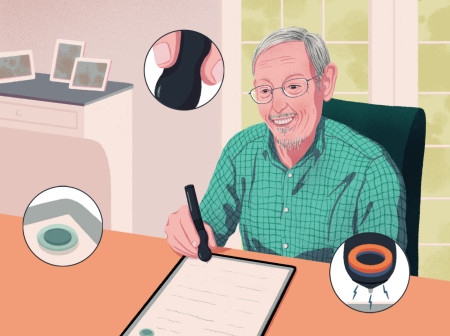Gass Iyacu ’24 rode a scooter across Northwestern’s Evanston campus to get to class every day. Emma Jackson ’24 rode her bike. But neither regularly wore a helmet. Why?
“They just don’t fit!” says Iyacu, who wears his hair in various styles, such as an Afro or braids. Jackson has the same problem. Helmets typically frizz her hair and disrupt her natural curls.
Determined to find a solution, the two manufacturing and design engineering majors teamed up with classmates Pratham Bansal ’24, Alicia Cabrera ’24 and Kevin Kaspar ’24 to create the CALYX helmet system, an expandable helmet and accessory that accommodates thick, curly and voluminous hair while prioritizing safety and proper ventilation. “People of color change their hair a lot,” says Jackson, “and in our research, we saw people saying they have to buy a new bike helmet for all their different hairstyles — that’s a lot of money! We want our model to be cost effective.
“We also want users to come away from wearing this bike helmet without damaged hair,” adds Jackson. So the team developed a stretchy, breathable accessory made of satin and spandex that compresses the user’s hair without disrupting curl patterns or causing frizz. A grippy, elastic strip at the front and pull tab at the back help secure the accessory in place. Wearing the accessory “pushes the hair toward the back of the head,” says Iyacu, which then allows the helmet to fit over the user’s head more easily.
To build the helmet’s hard outer shell, the team used two separate pieces of expanded polystyrene (EPS) foam, a material used in most helmets on the market. What sets this design apart, says Jackson, is the expansion mechanism. “Our helmet can be used in standard and expanded positions,” says Iyacu. To expand the helmet, the user unfastens the Velcro straps along the top, allowing the back portion of the helmet to slide back and create more space for the user’s hair. Then the user can put on the helmet and refasten the Velcro straps.
This spring, the team visited Virginia Tech’s world-renowned helmet testing lab, where their helmet prototype performed better than a 5-star helmet, the lab’s highest-rated helmet for reducing the risk of concussion. “Due to our design having two separate shells, it dissipates impact energy far better than a single-shell helmet,” says Iyacu.



Reader Responses
This is brilliant — so useful for all riders with thick or curly hair — and I love the level of thought that has gone into it, especially making sure to protect the hair and avoid frizz! This makes it way more likely people will actually use it. I can't wait to purchase when it's available!
—Kathryn Jackson-Jones Chicago, via Northwestern Magazine
Absolutely what is needed. My grandson has this same opposition to wearing a helmet when on his skateboard.
When will this helmet be available on the market?
I am so proud!
—Regina Driskill '75, Memphis
Thank you for the article about Northwestern University students working to reduce hurdles to the use of helmets by bicyclists and scooter riders.
Bicyclist deaths in the United States have increased 16% since I graduated from NU’s McCormick School of Engineering in 1986. They’re up 75% since reaching the lowest number in 2010. More than 1,000 cyclists were killed on U.S. roads in 2022. The number of scooter riders killed is not well documented but growing due to the increasing popularity of this mode of transportation.
Wearing a helmet is the one thing cyclists and scooter riders can do to protect themselves from the potentially devastating effects of crashing. Yet, 62% of cyclists killed in 2022 were not wearing one. Discomfort and the effects on one’s hair are often cited as reasons people don’t wear them. Thus, efforts to address these concerns as undertaken by the enterprising students to develop the CALYX helmet system are well warranted.
I was inspired to write to you because their work intersected with work to which I contributed. The Insurance Institute for Highway Safety partly funded Virginia Tech’s development of their bicycle helmet rating system New tests show some bike helmets protect better than others. I was encouraged to see that the developers of the CALYX system were using our work to make sure that their helmet provides protection against common concussion injuries in addition to the protection required by helmet safety standards.
It's nice to see the work of different generations of NU alumni coming together to serve a common good.
—David Zuby '86, Charlottesville, Va.
No one has commented on this page yet.
Submit a Response